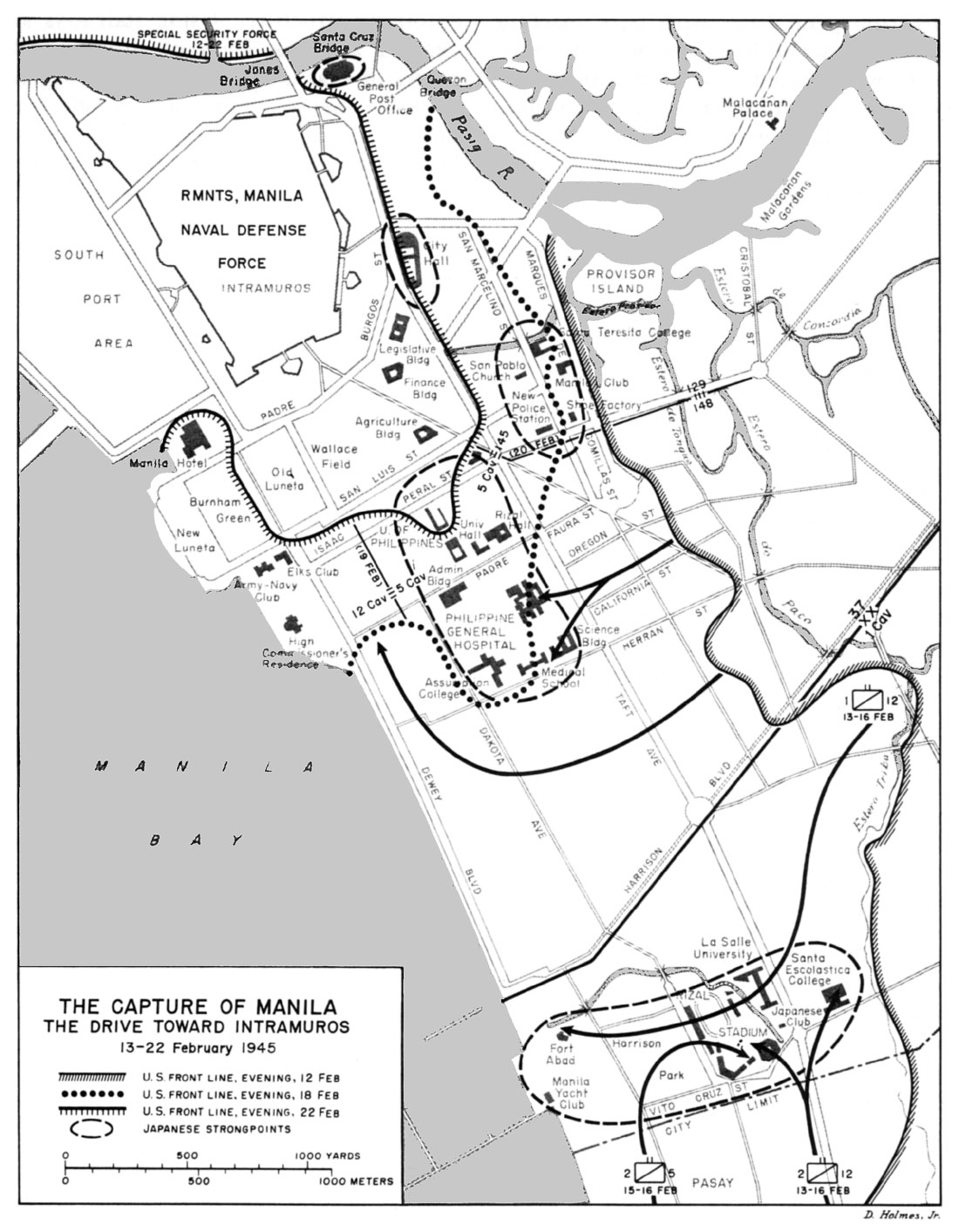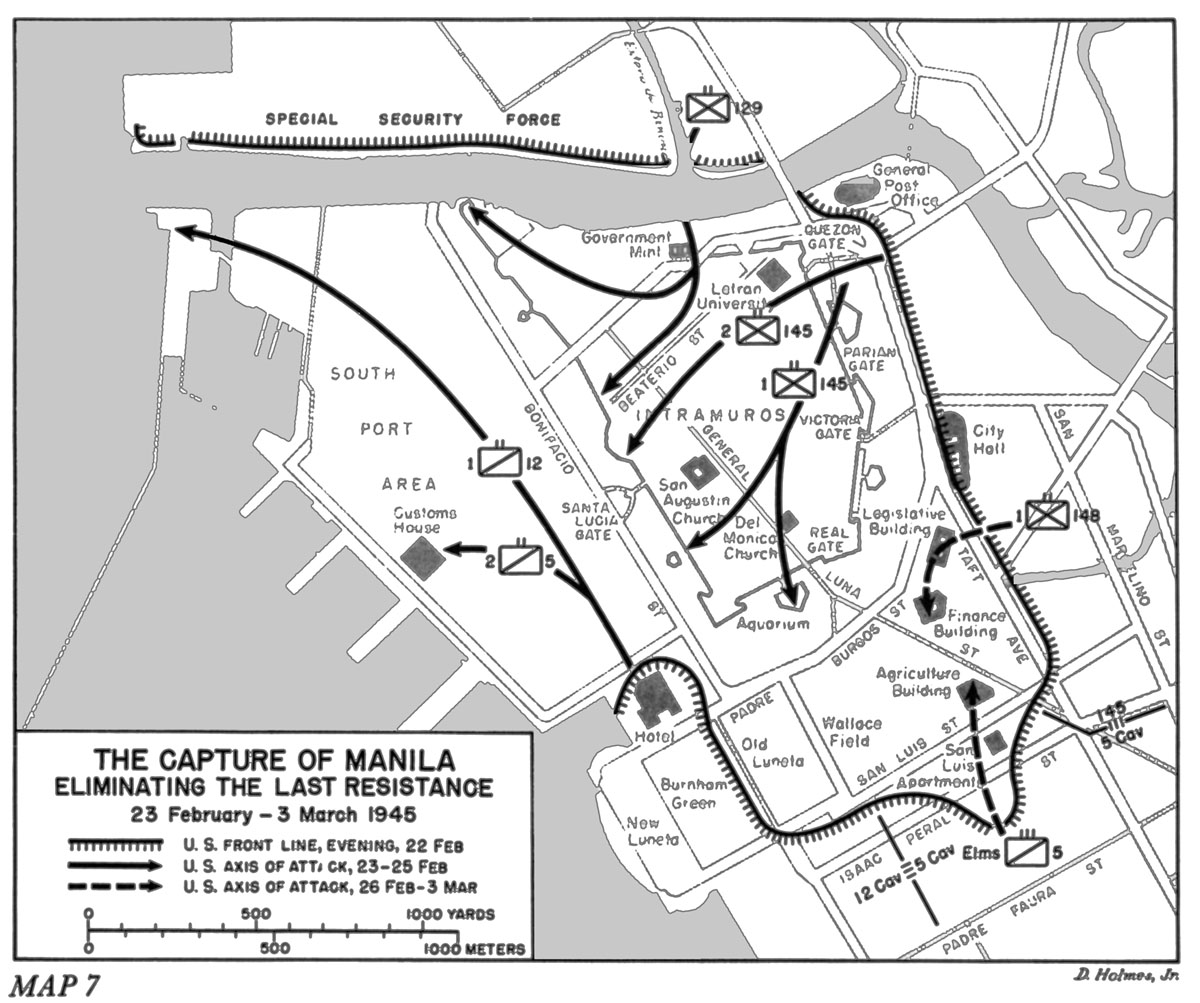Protip for all the backup quarterbacks of the world: Shut up.
We’re coming up on the end of the combat history of the 37th Infantry in the Second World War- we’ll be done next week, in fact. If you have anything in particular you want to talk about next, please say so- otherwise, it’ll be the Battle of Thymbra after Rutgers in a couple of weeks. As usual, if you’re interested in talking more about the Battle of Manila, feel free to comment below. And if you want to look at some of the other good work that’s been done in military history on this site, check out the archive by clicking here.
The March to Luzon
In many ways, the story of SoWestPac command in World War II is the story of a march from Guadalcanal in the Solomons to Luzon. There are plenty of reasons why this occurred- the Philippines were a significant base for the Japanese, which threatened the flank of Central Pacific’s march towards the Japanese Home Islands, the desire to liberate a prewar ally, the Commonwealth of the Philippines, and Douglas’ MacArthur’s desire to fulfill his promise to return to the islands he had abandoned in 1942.
After the defeat of the Japanese on Bougainville, US forces completed the encirclement of Rabaul- and, with that completed, the Allies decided to not bother invading New Britain and assaulting Rabaul directly. Rather than take the time, and the casualities, required to reduce the nearly 100,000 man garrison, the Allies decided to simply let them all starve- the airbase was destroyed, the planes there all burned, and no Japanese ships could operate from there due to a lack of fuel.
Instead, the Allies pushed east along to main routes. One was an “island” hopping campaign down the coast of New Guinea, landing in poorly defended areas long enough to establish a new base, fight off a Japanese counterattack, and move on to the next base area. While not involving large numbers of men, typically, the fighting was often brutal, close range jungle fighting, while the SeaBees and Combat Engineers rushed to build fortifications and bases in order to rush to the next base. This drive ended with the capture of Sansapor on New Guinea, which then opened the way to the capture of Morotai, which would be one of the staging bases for the invasion of Leyte.
Moving across the Pacific, the Americans also launched offensives aimed at the Marshall Islands, from which B-29s could stage air raids against the Japanese Home Islands, and would serve as bases for the moves against Iwo Jima and Okinawa. However, first, the Americans had to reduce the Japanese base at Truk. Similarly to Rabaul, the Americans decided to isolate, then neutralize, the Japanese base by air and sea, rather than directly attack the Japanese garrison. With Truk reduced, the bulk of the Pacific Fleet moved to establish bases in the Palaus and at Uluthi in order to support the Philippine invasion.

The invasion of Leyte was, more or less, an “All Hands” affair. Units from Central Pacific and Southwest Pacific came together in order to deliver the invasion fleet to Leyte. Leyte was chosen over Mindanao, despite the latter being closer to Allied bases, because it was small enough to secure quickly, and because Mindanao was just too obvious- the Japanese had loaded the island with troops. The fighting was hardly unopposed- the Japanese Imperial Navy made its last major coordinated effort of the war to try and destroy the transports of Leyte, but were ultimately turned back and defeated in the largest naval battle in history- feel free to read about it here.

By the end of 1944, the Americans were in control of Leyte, and began turning the island into the base from which they would liberate the remaining islands. The next attack came in December, 1944, against Mindoro. The island was close to Manila, and could be used as a fighter base to control the air of Luzon. The island was almost under the complete control of Filipino guerillas, and fell quickly. It served as a base for squadrons of P-51s, the first to arrive in the Pacific, which had the range and dogfighting ability to sweep the Japanese from the sky over Luzon.

The Invasion of Luzon
On January 6th, the Americans staged for the invasion of Luzon, preparing to land at Lingayen Gulf. The Japanese responded by launching what remained of their air forces as Kamikaze attacks against the Americans. These were not the first attacks- the Japanese had been using them since October, but these attacks were much larger and better organized that those early attacks, and American anti-Kamikaze tactics were not well developed. This led to some casualties in the invasion fleet, but did not significantly impede the invasion. The 37th Infantry Division went ashore with the rest of Sixth Army on January 9th, who began the process of moving on Manila.

The 37th Division, along with the 1st Cav Division, drove south towards Manila, splitting Japanese resistance in the area. The two divisions moved quickly, attempting to break through Japanese positions on a race to the city itself. The terrain suited the drive, as it was open and flat, and most of the Japanese defenders were pulled out of the area into the highlands, where Yamashita, the Japanese commander, planned to make stands in more defensible terrain, and draw out the fighting as long as possible and with as high a casualty rate as he could manage. On the 31st of January, the 11th Airborne landed south of Manila, and began its own advance, moving to cut off the Japanese defenders of the city.

By February 3rd, American forces entered the outskirts of Manila. Elements of the 1st Cav began taking up positions around the city. They also liberated 4000 Filipino prisoners, while, the next day, the 37th Infantry rescued 1000 Americans, survivors of the Bataan Death March and other actions during the war, before the Japanese could massacre them. The 11 Airborne rushed in from the south in an effort to support the other two divisions as they moved into the city.
Yamashita has actually ordered the city’s garrison to abandon the city after destroying critical infrastructure in the city. However, the commander of the garrison was an Admiral, Sanji, and his troops were largely Naval Special Landing Force troops. He refused to accept Yamashita’s authority over his men, and fell back to the docks and the Intramuros district, which was already built as a fortress. His men further fortified the city. Shanji’s efforts also trapped as many civilians as he could in the area around his forces. Shanji had about 17,000 men, who faced 35,000 Americans and 3,000 Filipinos. Hundreds of thousands of civilians were trapped between the two armies.
The Battle of Manila
The plan for moving into Manila’s defended areas was pretty simple. The 37th Division would move into the north, while the 1st Cav would cut around and approach from the southeast. The 11th Airborne would move in to support the attacks from the south as soon as it could. The Paisag River, the main natural obstacle to the American advance, was breached on the 5th of February by US forces crossing the last bridge across the river, followed by more set up by engineers. Advanced US elements took key infrastructure features, including the powerplants and water works in the area over the course of the next few days.
However, the Japanese in these positions offered stiff resistance. At first, MacArthur, hoping to avoid damage to the city and the loss of serious civilian life, had restricted artillery and air attacks against the Japanese. However, heavy casualties in these engagements- about 1,000 total for the Americans, convinced the local commanders that it would be impossible to preserve much of the defended part of Manila- especially once word came that they hadn’t even reached the Japanese main line of resistance!
Given the large number of Japanese defenders, the Americans focused on securing the area around the Intramuros district, and waited for 11th Airborne to catch up, It wasn’t until February 12th that the Americans were fully ready to move on the Japanese positions. The Americans, in these sweeps, came to rely heavily on artillery and tank fire to demolish Japanese positions, which brought some civilian casualties. However, the Japanese waiting in their main defensive positions grew bored, indisciplined and antsy. An almost casual brutality came to dominate Japanese actions in the area. Gang rapes, beheadings, beatings and shootings were a common occurrence, as was the practice of herding Filipinos into buildings before setting them alight, then shooting anyone who ran out- not in any organized way, but just as a way to pass the time before various Japanese groups would stand and die.

On the 15th of February, Yamashita reiterated his order to abandon the city, and, to support the effort of the Japanese forces there to break out, ordered troops outside the city to attack the Americans as well. This counterattack came on the 17th of February, but was fairly feeble and ineffective. The 37th Infantry held the Japanese trying to break out, while the 11th Airborne handled the Japanese outside of the city. By the 18th, the Japanese gave up on the effort, and the 6,000 or so remaining defenders fell back to Intramuros, the Walled City part of Manila.

The burden of clearing Intramuros would fall to the 37th, while the 1st Cav would sweep down to the docks and clear out remaining Japanese in that area. The Americans took a few days to rest up and prepare for the assault on the walled city, launching the attack on the 23rd. This allowed detailed planning of the attack, which, along with thousands of bombs, artillery and tank shells and bazooka rounds, helped keep the casualties in the attack relatively low. The men of the 37th launched the main assault through the Quezon Gate into Intramuros, and began reducing the area block by rubbled block. The Japanese clung to some of the major administrative buildings, but did not have the ammunition or fire support to do anything more but try t sell their lives dearly. By the 25th, the men of the 37 had cleared Intramuros.

After the fall of Intramuros, the Americans held up again for a few days before launching the last attack against the Japanese in the Finance and Agricultural Ministry Buildings. This fighting took four days, from the 28th of February to the 3rd of March. By that day, four weeks after the battle began, Manila was cleared and under American control once again.

The battle was, in the end, bloody and destructive. Most of Manila was, effectively, leveled or in ruins. Thousands of buildings were in ruins. The buildings used by the Japanese as strong points, even as strongly built as they were, were destroyed. 1000 Americans died to liberate the city, 300 of them from the Buckeye Division. Another 5,500 were wounded, about 1000 from the 37th ID. Of the 20,000 Japanese defenders, 16,500 were found dead. The remainder were simply never seen again, alive or dead. At least 100,000 Filipino civilians were massacred by the Japanese, while thousands more died in the fighting. The battle would claim one more casualty after the war, when Yamashita was executed for the Manila Massacres.

There was one more big battle left for the Buckeye Division, after it recovered from taking Manila.
